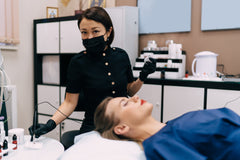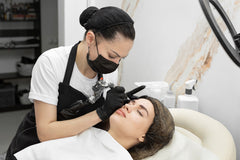📦 Free Shipping for orders of $300 or more. USPS Priority Mail Express days only applies when ordered before 1:00 pm California time. 🔷 Become a BC Member and receive free shipping on all orders no minimums! Free shipping is only offered to USA and Puerto Rico orders. Learn More >> 🔷
📦 Free Shipping for orders of $300 or more. USPS Priority Mail Express days only applies when ordered before 1:00 pm California time. 🔷 Become a BC Member and receive free shipping on all orders no minimums! Free shipping is only offered to USA and Puerto Rico orders. Learn More >> 🔷
All You Need to Know About Microblading Ink...

All You Need to Know About Microblading Ink and Pigment
- Admin .
- -
- May, 22 , 22
Microblading is one of the most exciting and fulfilling beauty treatment experiences today. It helps people with scattered and sparse eyebrows achieve a fuller brow look. But just like deciding which store you want your first microblading procedure to happen, choosing the microblading ink or pigment is difficult too. You have a lot of things to consider, such as your skin tone, skin type, pigment type, microblading color, harmful chemicals in a microblading ink, pigment standards, and many others.
To help you know these things, we have listed the basics about the microblading ink and pigment:
Tones and Types of the Skin
In microblading, aestheticians do not apply a random ink to your brows to say it's microbladed. Instead, they match the ink to your skin so your eyebrows won’t stand out awkwardly. When it comes to skin tones, light, medium, and deep are the general colors. Meanwhile, common skin types are normal, dry, oily, and combination skin.
Types of Microblading Pigment/Ink
The quality of pigment matters in a microblading treatment. There are instances when an aesthetician doesn’t pay much attention or has little knowledge about inks and pigments. As a result, people who recently have undergone microblading procedures have faded or oxidized brows. This is because of the poor quality of the inks used. As such, it is best to choose what type of pigment you’ll go with.
Harmful Chemicals in Some of the Microblading Pigments and Inks
Before starting your microblading procedure, it's important to know if the inks are safe. Feel free to ask your beauty technician about them. You can also check the ink label to know if the ingredients are harmful to your skin. Keep in mind the following for safety purposes:
-
Titanium Dioxide
-
DMDM Hydantoin
-
Isopropyl Alcohol
The Beauty Ink Store Microblading Ink and Pigment Standards
- Clean and stable pigment
- Pure formula
- Highest quality
- True to color
- Metal-free
- Cruelty-free
- Shorter healing time
- Made with bioinert materials
Before you decide to have a microblading treatment, you should know the basics. Especially the microblading ink and pigment. If you are interested in buying the best pigments, you can order them at The Beauty Ink Store. Also, check our collection of microblading pigments today.
← Older Post Newer Post →
Search
Recent Post
Color Correction ...
Oct 15, 2025Permanent Makeup ...
Sep 05, 2025Pigment Correctio...
Aug 08, 2025Archive
- September 2025
- April 2025
- February 2025
Tags
Custom Menu
Added to cart successfully!




